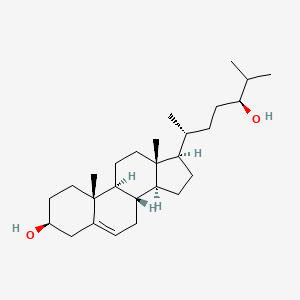
|
Cerebrosterol |
Cerebrosterol is a lipid of Sterol Lipids (ST) class. Cerebrosterol is associated with abnormalities such as nervous system disorder, Neurodegenerative Disorders, Alzheimer's Disease, Senile Plaques and Hypercholesterolemia. The involved functions are known as Blood - brain barrier function, Oxidation, 5-(carboxyamino)imidazole ribonucleotide mutase activity, cholesterol biosynthetic process and Anabolism. Cerebrosterol often locates in Hepatic, Body tissue, Autosome, brain tissue surgical material and Tissue membrane. The associated genes with Cerebrosterol are CYP27A1 gene, Alleles, INS gene, Apolipoprotein E4 and PLXNB1 gene. The related lipids are Sterols, 7-dehydrocholesterol, 27-hydroxycholesterol, 24-hydroxycholesterol and Dehydrocholesterols. The related experimental models are Mouse Model. |
146 |
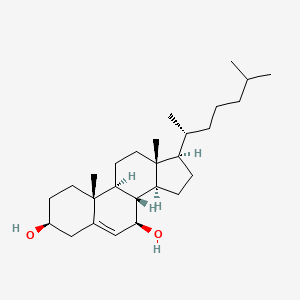
|
7beta-Hydroxycholesterol |
7beta-Hydroxycholesterol is a lipid of Sterol Lipids (ST) class. 7beta-hydroxycholesterol is associated with abnormalities such as Hyperglycemia, Atherosclerosis, Coronary heart disease, Coronary Stenosis and Unstable angina. The involved functions are known as DNA Fragmentation, Apoptosis, Cell Death, Stimulus and caspase activation. 7beta-hydroxycholesterol often locates in Tissue membrane and Frozen Sections. The associated genes with 7beta-Hydroxycholesterol are FGF6 gene. The related lipids are Hydroxycholesterols, Total cholesterol, Sterols, 7-ketocholesterol and Cholestenes. |
85 |
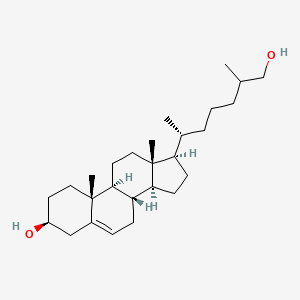
|
26-Hydroxycholesterol |
26-Hydroxycholesterol is a lipid of Sterol Lipids (ST) class. 26-hydroxycholesterol is associated with abnormalities such as Cardiovascular Diseases, Vascular Diseases, Metabolic syndrome, Obesity and Fatty Streak, Arterial. The involved functions are known as Oxidation, phospholipase activity, glucose metabolism, Binding (Molecular Function) and Regulation. 26-hydroxycholesterol often locates in Immune system, Body tissue, Extracellular, Protoplasm and Back. The associated genes with 26-Hydroxycholesterol are Homologous Gene, chylomicron remnant, Receptor Gene, Alleles and D3 compound. The related lipids are 27-hydroxycholesterol, Hydroxycholesterols, Lysophosphatidylcholines, Total cholesterol and Lipopolysaccharides. The related experimental models are Knock-out and Transgenic Model. |
203 |
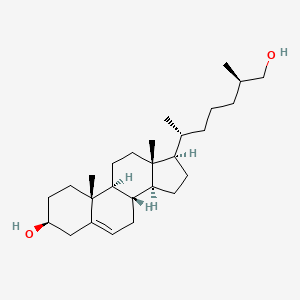
|
27-hydroxy-cholesterol(25R) |
27-hydroxy-cholesterol(25r) is a lipid of Sterol Lipids (ST) class. 27-hydroxy-cholesterol(25r) is associated with abnormalities such as Consumption-archaic term for TB and Kozlowski Celermajer Tink syndrome. The involved functions are known as CYP27A1activity, mRNA Expression, Anabolism, Steroid biosynthesis and Metabolic Process, Cellular. 27-hydroxy-cholesterol(25r) often locates in Body tissue, soluble, Mitochondria and Inner mitochondrial membrane. The associated genes with 27-hydroxy-cholesterol(25R) are ABRA gene, IGKV1-16 gene, HSD3B1 gene, CYP21A2 gene and TSPO gene. The related lipids are Steroids and cholesterol analog. |
183 |

|
apigenin |
apigenin is a lipid of Polyketides (PK) class. Apigenin is associated with abnormalities such as Morphologically altered structure, Chimera disorder, Hypertensive disease, infection induced and Infection. The involved functions are known as inhibitors, Gene Expression, Process, Metabolic Inhibition and Cell Death. Apigenin often locates in Vacuole, Cytoplasmic matrix, Cytoplasm, Tissue membrane and Membrane. The associated genes with apigenin are MSMP gene, BCL2 gene, PTGS2 gene, Chromatin and SLC33A1 gene. The related lipids are Lipopolysaccharides, Steroids, 1-Butanol, agosterol A and Butyrates. The related experimental models are Mouse Model, Tissue Model, Knock-out, Xenograft Model and Disease model. |
4250 |

|
baicalein |
baicalein is a lipid of Polyketides (PK) class. Baicalein is associated with abnormalities such as Neurodegenerative Disorders, Fibrillation, Hypertensive disease, Aortic coarctation and Coronary Occlusion. The involved functions are known as Anabolism, Polymerization, Process, inhibitors and Pathogenesis. Baicalein often locates in Membrane, Lipid Bilayers, soluble, Cell-Free System and Protoplasm. The associated genes with baicalein are P4HTM gene, BIRC5 gene, TSPO gene, SHOC2 gene and XIAP gene. The related lipids are Fatty Acids, Nonesterified Fatty Acids, iodoresiniferatoxin, Lipopolysaccharides and 17-octadecynoic acid. The related experimental models are Knock-out, Mouse Model and Parkinsonism, Experimental. |
1997 |
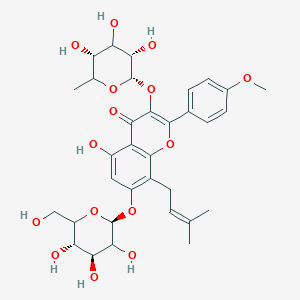
|
LMPK12112009 |
LMPK12112009 is a lipid of Polyketides (PK) class. |
216 |
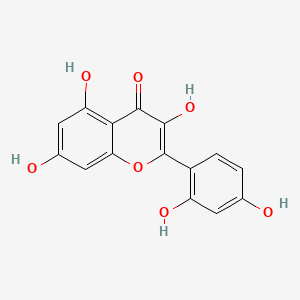
|
morin |
morin is a lipid of Polyketides (PK) class. Morin is associated with abnormalities such as Colitis, Hyperuricemia, Gout, Parkinson Disease and Rheumatoid Arthritis. The involved functions are known as establishment and maintenance of localization, Binding (Molecular Function), Uptake, Increased Sensitivy and Cell Cycle Arrest. Morin often locates in Cell Wall, apoplast, Plasma membrane, Cytoplasmic matrix and Membrane. The associated genes with morin are GADD45A gene, MAPK8 gene, ODAM gene, TNFRSF1A gene and ALPP gene. The related lipids are Lipopolysaccharides, Butyrates, Fatty Acids, Nonesterified, Palmitates and Oleates. |
1499 |

|
naringenin |
naringenin is a lipid of Polyketides (PK) class. Naringenin is associated with abnormalities such as Dehydration, Papillon-Lefevre Disease, BOSLEY-SALIH-ALORAINY SYNDROME, Cardiovascular Diseases and Atherosclerosis. The involved functions are known as Pigmentation, Biosynthetic Pathways, metaplastic cell transformation, 4-coumarate-CoA ligase activity and Pigment. Naringenin often locates in Body tissue, Cell Wall, Membrane, Cytoplasmic matrix and Tissue membrane. The associated genes with naringenin are Genome, Genes, Regulator, Alleles, Homologous Gene and SPEN gene. The related lipids are Fatty Acids, Total cholesterol, Lipopolysaccharides, Oleates and Cholesterol, Dietary. The related experimental models are Knock-out and Mouse Model. |
2420 |
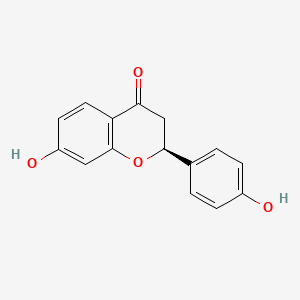
|
Liquiritigenin |
Liquiritigenin is a lipid of Polyketides (PK) class. Liquiritigenin is associated with abnormalities such as POSTMENOPAUSAL SYNDROME, Hyperostosis, Diffuse Idiopathic Skeletal, PARAGANGLIOMAS 2, Wiskott-Aldrich Syndrome and Alzheimer's Disease. The involved functions are known as Heterodimerization, Transcription, Genetic, Ligand Binding, Transcriptional Activation and Anabolism. Liquiritigenin often locates in Membrane, Blood, Microsomes, Liver, Microsomes and Body tissue. The associated genes with Liquiritigenin are Candidate Disease Gene, IMPACT gene, TNFSF10 gene, SLC33A1 gene and P4HTM gene. The related lipids are Lipopolysaccharides, pregnenolone sulfate and FuGene. The related experimental models are Xenograft Model. |
313 |
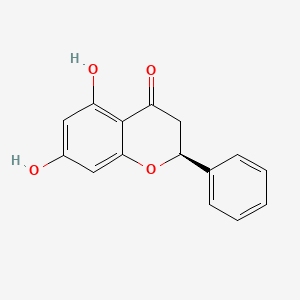
|
Pinocembrin |
Pinocembrin is a lipid of Polyketides (PK) class. Pinocembrin is associated with abnormalities such as Exanthema. The involved functions are known as Anabolism, Sulfation, Vmax, flavonoid biosynthetic process and Cell Death. The associated genes with Pinocembrin are SULT1A1 gene and NKS1 gene. |
172 |
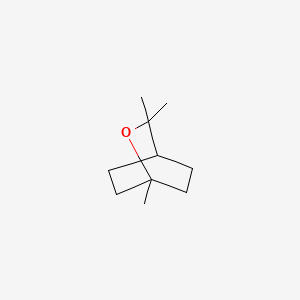
|
1,8-Cineol |
1,8-cineol is a lipid of Prenol Lipids (PR) class. The involved functions are known as Amplification, enzyme activity and inhibitors. 1,8-cineol often locates in subsynaptic reticulum. The related lipids are palmitoleic acid, pentadecanoic acid, stearic acid and erucic acid. |
1326 |
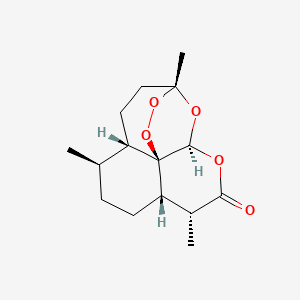
|
Artemisin |
Artemisin is a lipid of Prenol Lipids (PR) class. Artemisin is associated with abnormalities such as Malaria, Falciparum. The involved functions are known as Pressure- physical agent and secondary metabolic process. |
4738 |

|
Thapsigargin |
Thapsigargin is a lipid of Prenol Lipids (PR) class. Thapsigargin is associated with abnormalities such as Impaired glucose tolerance, Obesity and Blood Pressure Disorders. The involved functions are known as Phosphorylation, establishment and maintenance of localization, Regulation, Metabolic Inhibition and Proteolysis. Thapsigargin often locates in Mouse Skin, Cytoplasm, Skin, Protoplasm and Mitochondria. The associated genes with Thapsigargin are ERBB4 gene, F11 gene, CA1 gene, TRNAP1 gene and HSPA5 gene. The related lipids are taurolithocholic acid 3-sulfate, Liposomes, Fatty Acids and stearylamine. The related experimental models are Mouse Model. |
8868 |

|
forskolin |
Forskolin is a lipid of Prenol Lipids (PR) class. Forskolin is associated with abnormalities such as Cholestasis, Vocal cord dysfunction familial, Hypothyroidism, Renal tubular disorder and Disintegration (morphologic abnormality). The involved functions are known as Cell Proliferation, Anabolism, mRNA Expression, Agent and Signal. Forskolin often locates in Extracellular, Body tissue, Skin, Tissue membrane and Membrane. The associated genes with forskolin are P4HTM gene, SLC33A1 gene, NR1I2 gene, Genes, Reporter and CYP3A gene. The related lipids are Steroids, steroid sulfate, Fatty Acids, LYSO-PC and Lipopolysaccharides. |
24755 |

|
cholesterol |
cholesterol is a lipid of Sterol Lipids (ST) class. Cholesterol is associated with abnormalities such as Trypanosomiasis, Chagas Disease, Cleft Palate, Chondrodysplasia punctata 2, X-linked dominant and Child syndrome. The involved functions are known as Blood Circulation, Sterol Biosynthesis Pathway, Receptor Mediated Endocytosis, Methylation and Signal. Cholesterol often locates in Animal tissue, Blood, Membrane, Plasma membrane and peroxisome. The associated genes with cholesterol are MBD2 gene, SIM, SLC33A1 gene, Genome and NSDHL gene. The related lipids are Sterols, zymosterol, fecosterol, Total cholesterol and 7-dehydrocholesterol. The related experimental models are Mouse Model, Knock-out, Genetically Engineered Mouse and Disease model. |
98461 |















